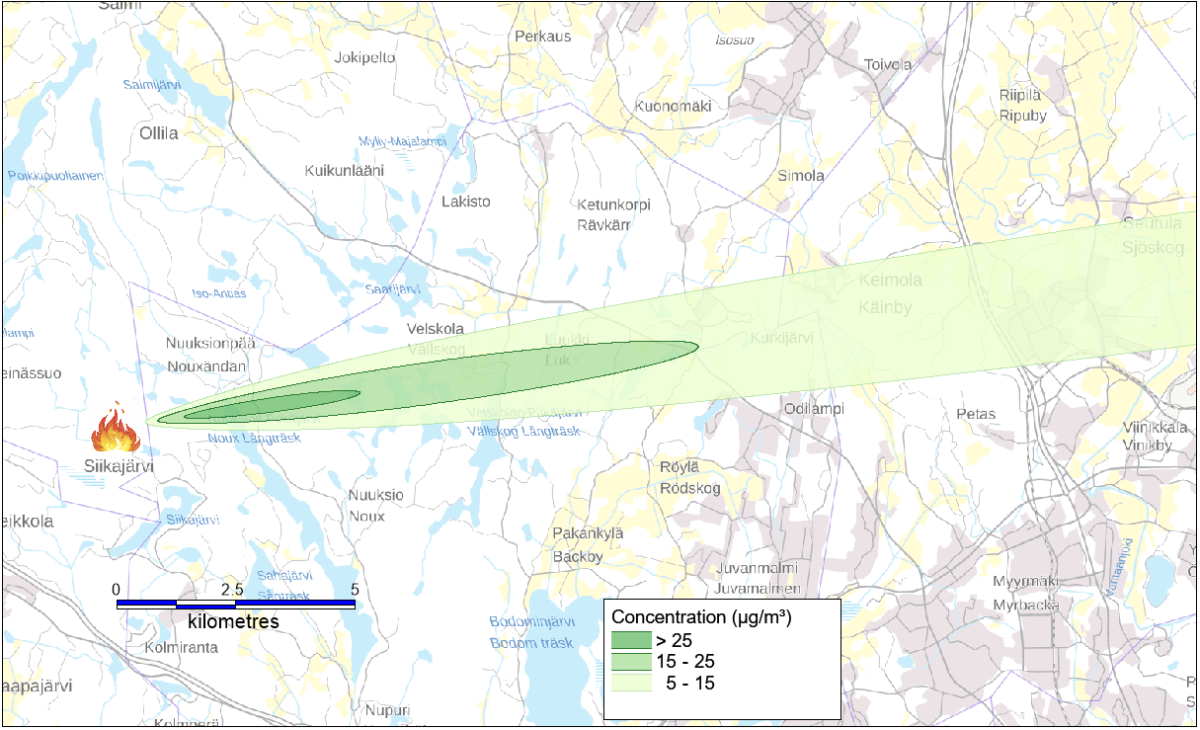Dispersion modelling of harmful substances originated from fires
Fine particles and flue gases originating from forest and warehouse fires both affect human health and contribute to climate change. The dispersion of plumes from fires can be estimated by a dispersion model developed at the Finnish Meteorological Institute, called BUOYANT.
Fires in warehouses and forest fires may represent a major hazard. These may cause health effects to people and harm the environment, and the fire plumes may contain harmful or toxic chemical compounds. Accurate predictions of the transport of harmful substances originated from fires can be used to reduce the health impacts and economic losses caused by such fires. The methods can be used, for example, in emergency contingency planning, in preparing for the consequences of conceivable fires, and in the safety analyses of industrial installations.
The BUOYANT model can be used for analysing the dispersion of plumes from fires
Dispersion of pollution from major fires can be estimated by a modelling system that contains source term, plume rise and dispersion models, developed at the Finnish Meteorological Institute. The dispersion model BUOYANT is a validated assessment tool for the consequence analysis of fire incidents involving harmful compounds. The mathematical structure and evaluation of the model against experimental data has been described by Kukkonen et al. (2014).
The model can be used for evaluating the formation of source terms, plume rise, and atmospheric dispersion of harmful chemicals. The model is applicable to evaluate the local and regional scale atmospheric dispersion of gases and particles originated from, for instance, forest, warehouse and liquid pool fires. A potential predicted concentration distribution of particulate matter (PM₂.₅) near ground level has been illustrated in the example figure.

An operational version of the BUOYANT model can be used by the rescue authorities
We have also developed an operational version of the BUOYANT model, called FLARE (Fire pLume model for Atmospheric concentrations, plume Rise and Emissions). This operational model application has been developed for the needs of the Finnish emergency authorities, including the rescue services. The aim was to provide estimates for emergency response personnel about the nature and spatial extent of hazards associated with major fires. The model is used via a graphical user interface, which is based on web-browser technology.
The software has been designed to utilise in real-time the meteorological data produced by numerical weather prediction (NWP) models. Automatic utilization of NWP-model products simplifies the input data, which a user has to provide, and this will result in a more fluent use of the model, and commonly also to more reliable and accurate predictions. The user needs to specify only the input data regarding the characteristics of the fire: the type and extent of the fire and its associated details, and the location and time of the fire event.
The scope of the model
The BUOYANT model is applicable for evaluating the local and regional scale dispersion of a continuous plume from a fire. The model has not been designed for evaluating the dispersion of hazardous materials originating from, for example, an industrial process failure, accident or terrorist attack. Another model (ESCAPE) developed at the Finnish Meteorological Institute can be used to estimate the consequences of chemical accidents.
The model is also limited in its ability to account for the detailed effects associated with complex terrain, buildings and other obstacles. The current model version does not allow for chemical transformation or wet deposition. Further, the detailed description of time-varying fires is outside of the scope of the model.
The model predictions have been extensively evaluated against experimental data
The plume rise predictions of the model have recently been evaluated against two large-scale experimental field datasets regarding prescribed wild-land fires. The results indicated a good agreement between predictions and measurements. The model has also been tested against experimental field dataset of releases from a stack of a major power plant. The overall agreement of the predictions and the data was good.
The plume rise treatment of the model has been evaluated against wind tunnel experiments. The predicted final heights of the plumes were in reasonable agreement with experimental data. Further, comparison of the plume rise predictions against remote sensing observations showed a relatively good agreement of the model, with a slight tendency towards underestimation in the final plume rise.
Acknowledgements
The operational version of the model has been developed with the help of the financial support of the Fire Protection Fund in Finland. A previous version of the BUOYANT model was developed in an EU-funded project in collaboration with the AEA Technology plc (U.K.), the Integral Science and Software (U.K.) and the University of Hamburg.
Literature
Kukkonen, J., Nikmo, J., Ramsdale, S.A., Martin, D., Webber, D.M., Schatzmann, M. and Liedtke, J., 2000. Dispersion from strongly buoyant sources. In: Gryning, S.-E. and Batchvarova, E. (eds.), Air Pollution Modeling and its Application XIII, Kluwer Academic/Plenum Publishers, pp. 539-547, doi:10.1007/978-1-4615-4153-0_55.
Kukkonen, J., Nikmo, J., Sofiev, M., Riikonen, K., Petäjä, T., Virkkula, A., Levula, J., Schobesberger, S. and Webber, D.M., 2014. Applicability of an integrated plume rise model for the dispersion from wild-land fires. Geosci. Model Dev. 7, pp. 2663-2681, doi:10.5194/gmd-7-2663-2014.
Martin, D., Webber, D.M., Jones, S.J., Underwood, B.Y., Tickle, G.A., and Ramsdale, S.A. , 1997. Near- and intermediate-field dispersion from strongly buoyant sources, AEA Technology Report AEAT/1388, Warrington, 277 pp.
Nikmo, J., Tuovinen, J.-P., Kukkonen, J. and Valkama, I., 1997. A hybrid plume model for local-scale dispersion. Finnish Meteorological Institute, Publications on Air Quality 27. Helsinki, 65 p.
Nikmo, J., Tuovinen, J.-P., Kukkonen, J. and Valkama, I., 1999. A hybrid plume model for local-scale dispersion. Atmos. Environ. 33, pp. 4389-4399, doi:10.1016/S1352-2310(99)00223-X.
Ramsdale, S.A., Martin, D., Nikmo, J., Kukkonen, J., Liedtke, J. and Schatzmann, M., 1997. Dispersion from strongly buoyant sources – Overall executive summary. AEA Technology Report AEAT/1408, Warrington, 16 p.
Sofiev, M., Ermakova, T., and Vankevich, R., 2010. Evaluation of the smoke-injection height from wild-land fires using remote-sensing data. Atmos. Chem. Phys. 12, pp. 1995-2006, doi:10.5194/acp-12-1995-2012.
21.6.2021
